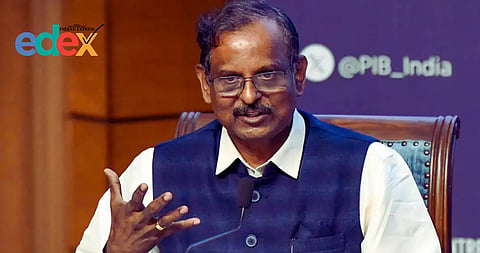

As many as 80,000 tests being completed in preparation for India’s first manned space mission, the Gaganyaan mission, and Indian Space Research Organisation (ISRO) scientists are ready to launch the first uncrewed mission, which is scheduled for December 2025, “at any given time”, ISRO Chairman V Narayanan said on Wednesday.
He, however, reiterated that they were fully ready to launch the first of the three uncrewed Gaganyaan mission flights, the date is yet to be finalised by Prime Minister Narendra Modi.
At the second day of the three-day Bengaluru Tech Summit-2025 on ‘India’s Space Vision 2047- Technologies, Challenges and the Way Forward’, he said the schedule for the Gaganyaan mission, the maiden manned mission of which is scheduled to be launched in the first quarter of 2027, and the setting up of the Bharatiya Antriksh Station (BAS), scheduled for 2035, is as per schedule. The first module for the parking of the BAS in space is scheduled to be lifted off into space in 2028. The 52-tonne BAS that will be assembled in space will be completed by 2035.
Explaining details of the upcoming Chandrayaan missions to the Moon, Narayanan said Chandrayaan-4 will be launched in 2027 and the configuration of the spacecraft is in its final stages. While the total mass of Chandrayaan-3 – which recorded India’s first successful lunar touchdown in August 2024 – was 3,900 kg, the mass of Chandrayaan-4 will be 9,600 kg. It has been designed to bring back samples from the Moon.
He said: “We deployed the best cameras on the Chandrayaan-2 orbiter. The best cameras are on the Moon and in its orbit. Now we are working on launching heavier landers and rovers on the Moon in the Lunar Polar Exploration (Lupex) mission (also called Chandrayaan-5) which will be done in partnership with Japan, and scheduled for 2028. High capacity lander development is under way for the three-month lunar exploration (for Chandrayaan-5).”
Comparing details of Chandrayaan-3 with Chandrayaan-5, Narayanan said the lander mass of the former was 1,747 kg while the latter will be 6,150 kg. The Chandrayaan-5 rover will weigh 350 kg, while that of Chandrayaan-3 weighed just 25 kg. The lunar mission life of Chandrayaan-5 will be 100 days as against just 14 days of Chandrayaan-3.
“After the Chandrayaan-4 mission, essential space infrastructure creation work will start in 2031-32; technology demonstrations of the new propulsion systems, lander and end-to-end systems will be held in 2033-37; first crewed lunar orbit mission is scheduled for 2038-39 and first crewed lunar lander mission for 2040,” he said, adding: “While the Venus Orbit mission is scheduled for 2028, we are seeking approval for the soft and safe landing on the Martian surface in 2030.”
Narayanan also announced targets set for increasing and strengthening India’s share in the global space sector. He said in 2023, India’s share in the global space economy was 2% (around 8.4 billion USD), which is aimed to be increased to 8% by 2035 (49 billion USD), 11% by 2047 (130 billion USD), and 15% by 2062 (374 billion USD). He said the aim is to achieve a three-fold increase in the number of satellites, from the present 57. Also, presently 12-18 launches are carried out annually, which will be increased to 50 per year in the next five years.
